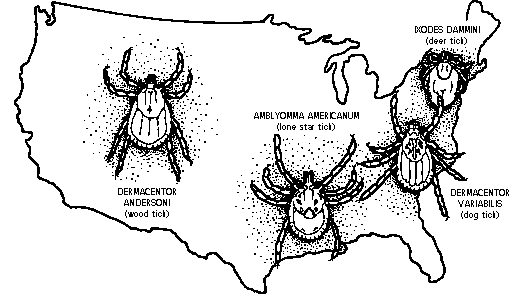11.09 Tick Removal
agk’s Library of Common Simple Emergencies
Presentation
The patient arrives with a tick attached to the skin, often the scalp, often frightened or disgusted and concerned about developing Lyme Disease, Rocky Mountain Spotted Fever or “tick fever.”
What to do:
- Promptly remove the tick. Grasp the tick with a pair of forceps and slowly pull up until the tick mouth parts separate from the skin.
- If the mouth parts remain embedded, anesthetize the area with an infiltration of 1% Xylocaine and use a # 10 scalpel blade to scrape (dermabrade) these fragments away.
- Instruct the patient or family to record the patient’s temperature daily for the next two weeks and to notify a physician or return to the ED at the first sign of a temperature above the baseline.
- If this was a 5mm Ixodes or deer tick, which was attached for more than a few hours, consider prescribing antibiotics to prevent Lyme disease (doxycycline 100mg bid x 10d, amoxicillin 500mg tid x 10d). Instruct the family to watch for a pink patch at the site, which could be the beginning of erythema chronica migrans.
- If this was a 1 cm Dermacentor or Amblyomma tick, reassure the patient and family that the likelihood of developing Rocky Mountain spotted fever is very small (l %) and that if it should occur, prompt treatment will be quite effective upon development of fever. It is counterproductive to give prophylactic antibiotics in an attempt to prevent RMSF.
What not to do:
- Do not use heat, occlusion, or caustics to remove a tick. A multitude of techniques have been promoted, but they may only increase the chance of infection.
- Do not contaminate your fingers with potentially infected tick products.
- Do not mutilate the skin attempting to remove the tick’s “head.” Usually what you see left behind is cememtum secreted by the tick, easily scraped off.
Discussion
Ixodes dammini, the tiny deer tick of New England, carries babesiosis and Lyme disease. Dermacentor variabilis, the dog tick, is the major vector of Rocky Mountain spotted fever, which is also carried by D. andersoni, the western wood tick, and Amblyomma americanum, the lone star tick. A. americanum has particularly long mouth parts, and its larvae are also capable of infesting human hosts. Other diseases carried by ticks include tick paralysis (usually cured by removing the tick), Colorado tick fever, relapsing fever, Q fever, Erlichosis and tularemia.
References:
- Needham GR: Evaluation of five popular methods for tick removal. Pediatrics 1985;75:997-1002.
- Magid D, Schwartz B, Craft J, Schwartz JS: Prevention of Lyme disease after tick bites. N Eng J Med 1992;327:534-541. (letters NEJM 1993;328:1418-1420.)
Illustration

-----------------------------------------------------
from Buttaravoli & Stair: COMMON SIMPLE EMERGENCIES ©
Longwood Information LLC 4822 Quebec St NW Washington DC 20016-3229
1.202.237.0971 fax 1.202.244.8393 electra@clark.net
-----------------------------------------------------

